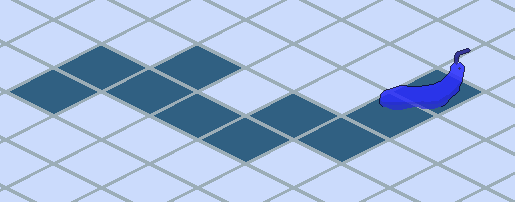NOTE - This post has been imported from the original post on ldjam.com
One of my favorite parts of building games is putting the player in a scenario where they can triumph and feel good about their victory. Enemy design is a key factor in making that come true. Art of the Kill (AotK) has a few interesting enemies to help generate these scenarios.
For starters, I knew I needed a generic enemy type. An enemy that is ridiculously easy to overcome, and feels satisfying to just mow through. This is where Enemy 1 comes in. They are very plain, they are slow, they have low health, and they deal little damage. They often show up in large numbers in the later half of the game to make up for their lacking strength. Attacking these guys is supposed to feel satisfying as you can kill them in two hits, quickly clearing a crowd if in the optimal position.

Next up, I needed a more vicious enemy. I took the base I had with Enemy 1 and made it a real threat. These turned into the red Clawer enemies. They move faster, have more health, and do more damage than Enemy 1. These guys don’t show up in groups larger than 5 for the most part, because they are a force to be reckoned with. They force the player to move around due to their high speed. This makes it tougher for the player to position themselves to mow down groups of Enemy 1!

At this point, I discovered the winning strategy for this game. To win all you had to do was strafe around the arena, swooping in to kill an enemy in the opportune spot, then bounce back to the outside and keep strafing. This made the game sorta boring in my eyes. The enemies were too dumb to prevent this from being a winning strategy, so I came up with a different type of enemy. This is when the Sucka enemy was born. The Sucka is a unique enemy in that it never attacks the player. The Sucka code literally doesn’t even have an attack function built into its loop logic.
What this forced the player to do, is move to the inside more often. The strafing strategy wasn’t totally ruined, but it was definitely made less effective. If the player just strafed around constantly, the Suckas would eat the perfectly placed tiles before the player could escape.
This led to some interesting levels where the player was forced to lure the Sucka into blue tiles so they could be killed to fill the tile. The Sucka doesn’t even move if there are no colors to eat! This did however, lead me to the fourth and final enemy I was able to implement in the 48 hour window.
The Slug is the counter to the Sucka. If a Slug appears on the map, it will randomly move about, ignoring the player unless they get too close. The trail it leaves behind GREATLY decreases the player’s score if it doesn’t get cleaned up, but it also lures Suckas away from potentially more valuable tile fills.

The Slug also comes in any of the three colors at random. This means they could be used to fill victory tiles be luring them over tiles to be filled, or that they could wander over tiles the player has painstakingly filled in. In later game levels, things can be chaotic and not noticing a slug can be a huge hamper to an otherwise winning strategy.
I hope you enjoy these write-ups on my game entry! If you haven’t given my game a try, why not try it now? I’d love to hear more feedback! If you have played it but not recently, give it another try. The difficulty was slightly toned down to allow players to advance further on less plays and see more of the content!